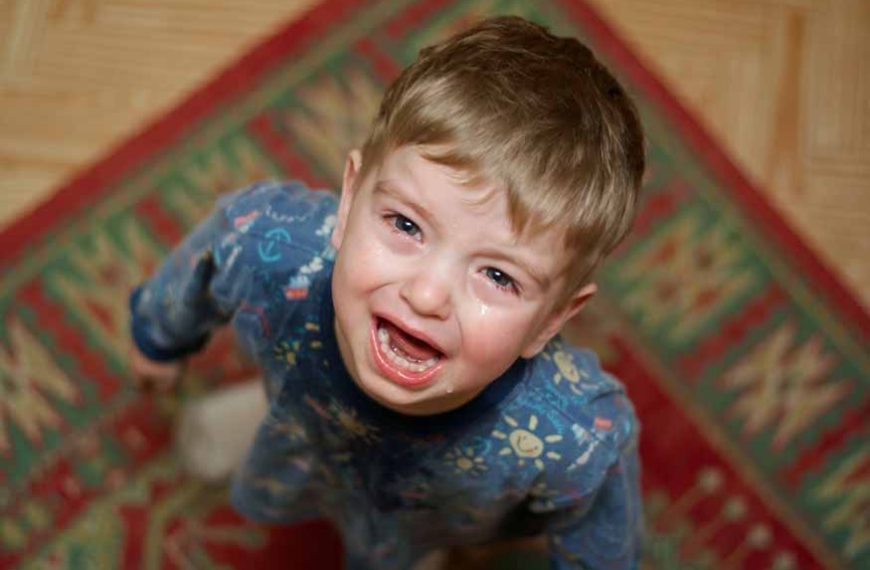Do you wonder ‘how to deal with toddler tantrums at bedtime?’
Kids’ bedtime can be a challenging time for parents, especially when dealing with toddler tantrums. The cries of a distressed child echoing through the house, the constant battles to stay awake, and the endless resistance to sleep can leave parents feeling perplexed and drained. Ever wondered why your toddler suddenly starts crying at bedtime? You’re not alone. In this blog, we will delve into the reasons behind these kids’ bedtime struggles and provide effective strategies to help you handle them with confidence and compassion. So, if you’re tired of the nightly battle and seeking answers on how to stop crying at night or how to handle 16-month-old tantrums, read on!
“Temper tantrums usually start at around 18 months and are very common in toddlers. Hitting and biting are common, too. One reason for this is toddlers want to express themselves but find it difficult. They feel frustrated, and the frustration comes out as a tantrum.”
NHS
3 Key Causes of Sleep Disturbance in Toddlers
Did you know the causes of toddler tantrums at bedtime? Here are 3 prominent reasons:
- Separation Anxiety
- Overtiredness
- Overstimulation
Separation anxiety is a common developmental stage that occurs around 16 months in toddlers. Toddlers become more aware of their surroundings and develop a stronger attachment to their parents. The fear of being separated from their loved ones can intensify at bedtime, leading to tears, clinging behaviour, and resistance to sleep. Understanding that separation anxiety is a normal part of their development can help parents approach bedtime temper tantrums with empathy and patience.
Toddlers may experience overtiredness if they haven’t had enough restorative sleep during the day or if their bedtime routine is inconsistent. Overtiredness is the one of the main reasons for toddler night tantrums and can manifest as increased crying, fussiness, and resistance to sleep at bedtime. Ensuring that your child gets sufficient daytime rest and establishing a consistent sleep schedule can help prevent overtiredness and promote a smoother bedtime routine.
Toddlers might get overstimulated because of their inherent curiosity and limitless energy, especially in the hours before bed. In the current times, overstimulation through technology is the key reason for toddler night tantrums. Activities such as playing with stimulating toys or engaging in screen time can make it challenging for toddlers to wind down and transition into a state of relaxation. The excess sensory input can overwhelm them, resulting in heightened emotions and tantrums. To minimise overstimulation, it’s essential to establish a calming routine before bedtime, avoiding stimulating activities and screens at least an hour before sleep.
5 Effective Ways to Handle Toddler Bedtime Tantrums
- Validate Emotions
- Offer Choices within Limits
- Use Positive Reinforcement
- Implement a Gradual Transition
- Provide Comfort and Security
When your toddler throws a tantrum at bedtime, it’s crucial to validate their emotions to ease the bedtime temper tantrum. Acknowledge their feelings and let them know that it’s okay to feel frustrated, scared, or upset.
Toddlers often crave a sense of control and independence. Providing them with limited choices within the bedtime routine can give them a sense of autonomy while still maintaining necessary boundaries. For example, you can let them choose which pyjamas to wear or which bedtime story to read. By offering choices, you empower your child and make them feel involved in the process, reducing resistance and tantrums.
Positive reinforcement can be a powerful tool in managing bedtime tantrums. Create a reward system where your child earns stickers or small tokens for positive behaviour and cooperation during bedtime. For example, if they go to bed without a tantrum for three consecutive nights, they can receive a small prize or special privilege. This positive reinforcement encourages and motivates your child to exhibit desired behaviour, making the bedtime routine more enjoyable for everyone involved.
Transitioning from playtime to bedtime can be challenging for toddlers. Implementing a gradual transition can help ease them into a more relaxed state. Start by engaging in calm activities, such as reading a book or cuddling, before transitioning to the actual bedtime routine for kids. By gradually winding down and transitioning, you give your child time to adjust and prepare for sleep, reducing the likelihood of tantrums.
Toddlers seek comfort and security from their caregivers, especially during moments of distress. During bedtime tantrums, offer physical comfort through gentle touches, such as back rubs, cuddles, or holding hands. Reassure your child with soothing words and a calming presence. Additionally, providing a comfort object like a favourite stuffed animal or blanket can help them feel secure and supported, easing their anxiety and promoting a sense of calm.
Establish a Comfortable Sleep Environment in 6 Beneficial Ways
The sleep environment plays a significant role in promoting restful sleep for toddlers. Consider the following factors to create an optimal sleep environment:
- Temperature and Ventilation
- Darkness and Light
- Noise Control
- Encourage Daytime Physical Activity
- Limit Stimulating Activities Before Bed
- Consistency is the Key
Ensure the room is at a comfortable temperature, neither too hot nor too cold. Use appropriate bedding and clothing to keep your child cosy during the night. Adequate ventilation and fresh air circulation in the room can also contribute to a better sleep environment.
Darkness is conducive to sleep as it signals the body to produce melatonin, the hormone that regulates sleep. Install blackout curtains or blinds to block out any external light sources that might disrupt your child’s sleep. However, some toddlers may feel more comfortable with a nightlight or a dim light in their room to alleviate fears of the dark. Find the right balance based on your child’s preferences.
Minimise noise disturbances that could interrupt your toddler’s sleep. Consider using white noise machines, soft music, or fans to create a consistent and soothing background sound that masks any disruptive noises from outside the room.
Physical activity during the day helps toddlers expend energy and promotes better sleep at night. Engage your child in age-appropriate active play, outdoor activities, or structured exercises.
Avoid activities that can overstimulate your toddler’s mind and body close to bedtime. These activities include watching stimulating TV shows or videos, playing energetic games, or engaging in exciting toys. Instead, encourage calm activities such as reading books, doing puzzles, or engaging in quiet play to help your child transition into a more relaxed state.
Consistency helps regulate your child’s internal body clock and establishes a predictable routine that signals it’s time to wind down and sleep. Consistent sleep and wake times, along with consistent bedtime routines, can greatly reduce bedtime tantrums and promote healthy sleep habits.
ConclusionToddler tantrums during bedtime can be perplexing and exhausting for parents. Understanding the reasons why toddlers suddenly start crying at bedtime and why they throw tantrums during this crucial period can help parents approach the situation with empathy and effective strategies. By establishing a calm bedtime routine, providing a soothing sleep environment, addressing fears and anxiety, and remaining calm and consistent, parents can help their little ones develop healthy sleep habits and ensure peaceful nights for the entire family. Which suggestion will you try – made up your mind yet?
We hope that you liked this blog. If you want to know such tips and tricks about parenting and child development, head to our blog section. In case you wish to know more about our specially curated curriculum, do visit the Eurokids centre nearest to your house!
For informative and accurate articles on all things related to your new born-toddler’s development, growth, health and nutrition, follow EuroKids Blogs and do check out our nationally recognized preschools – EuroKids for the first step in your kid’s educational journey!















